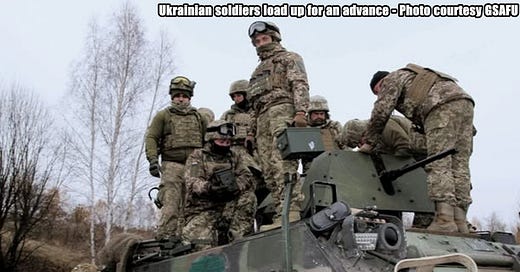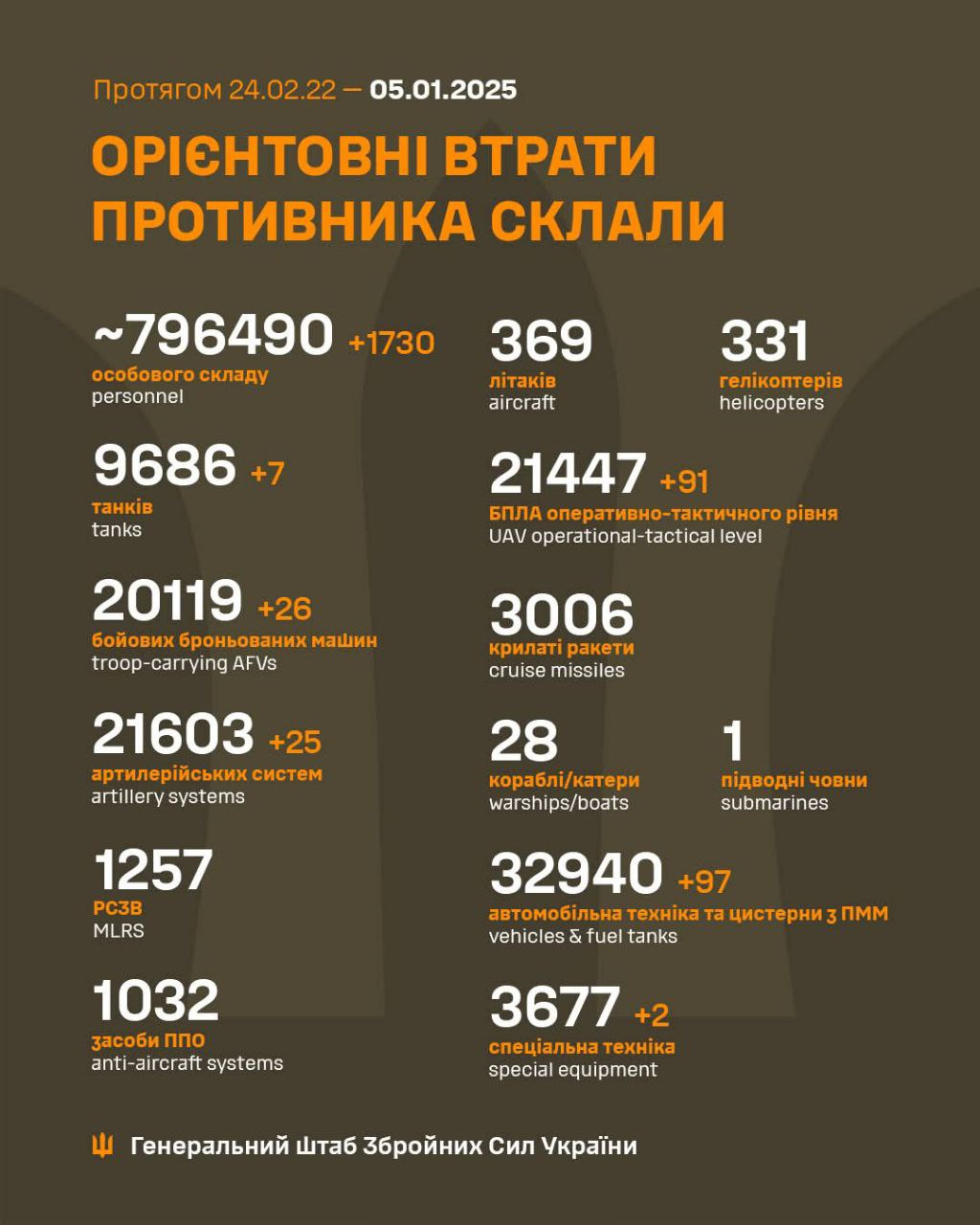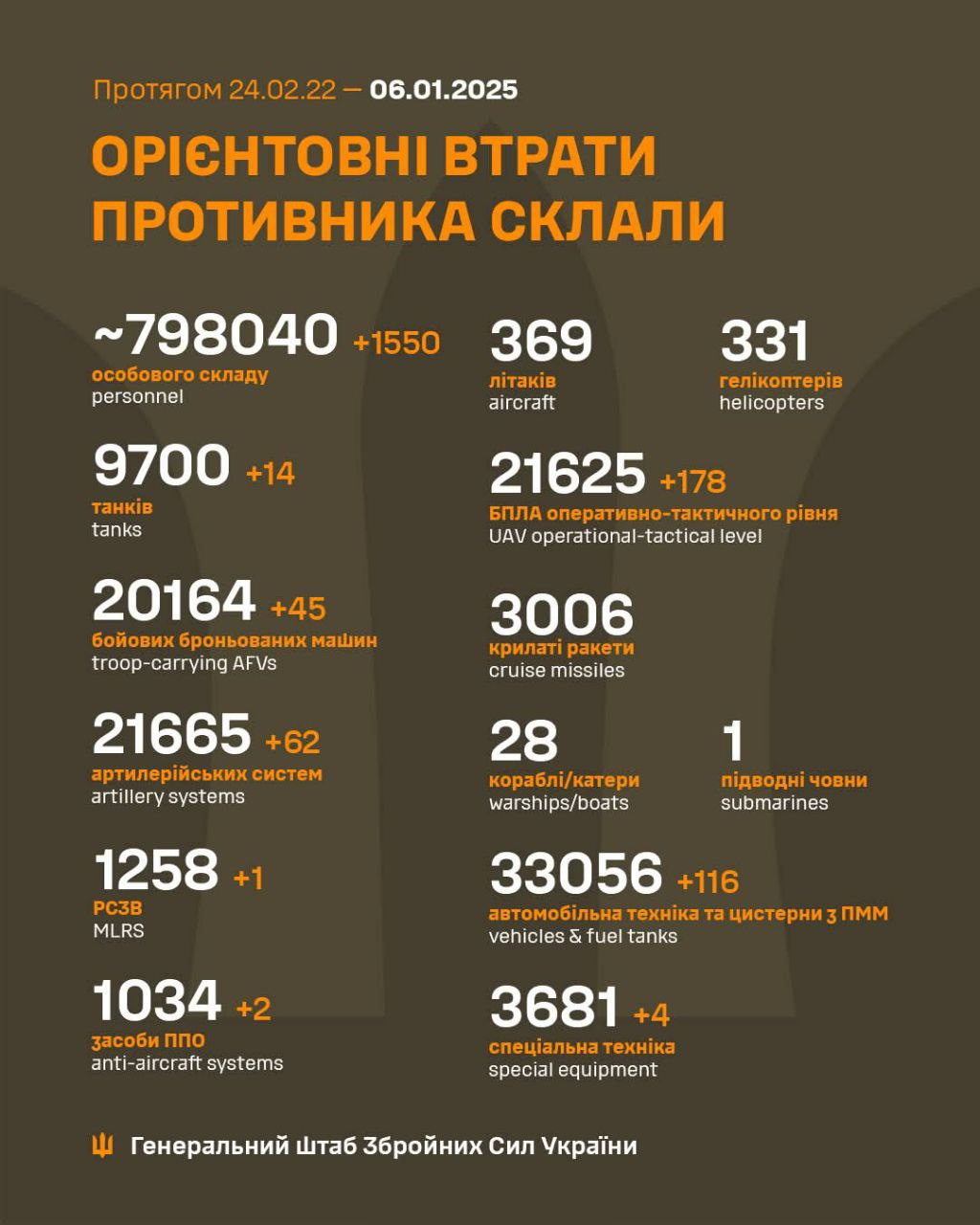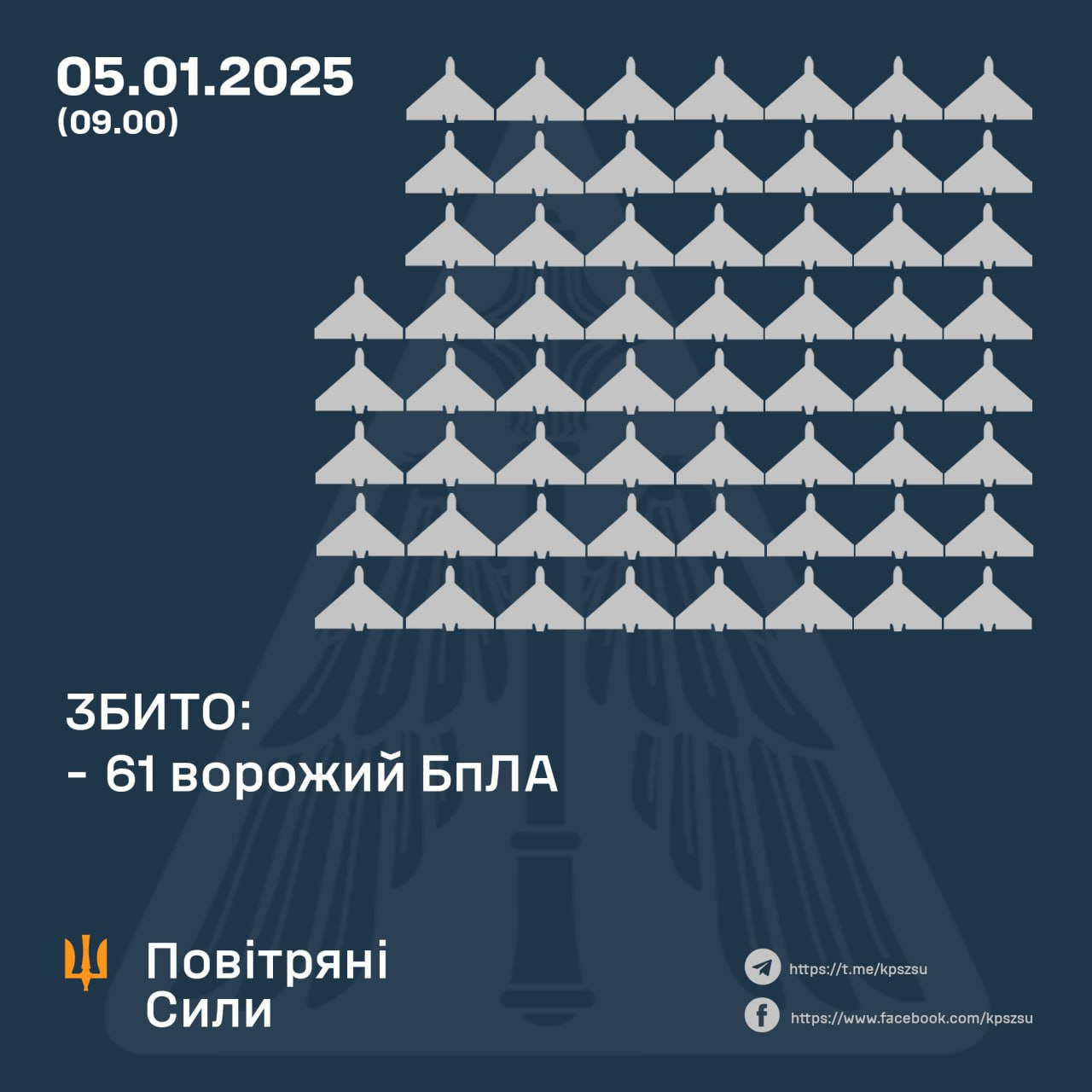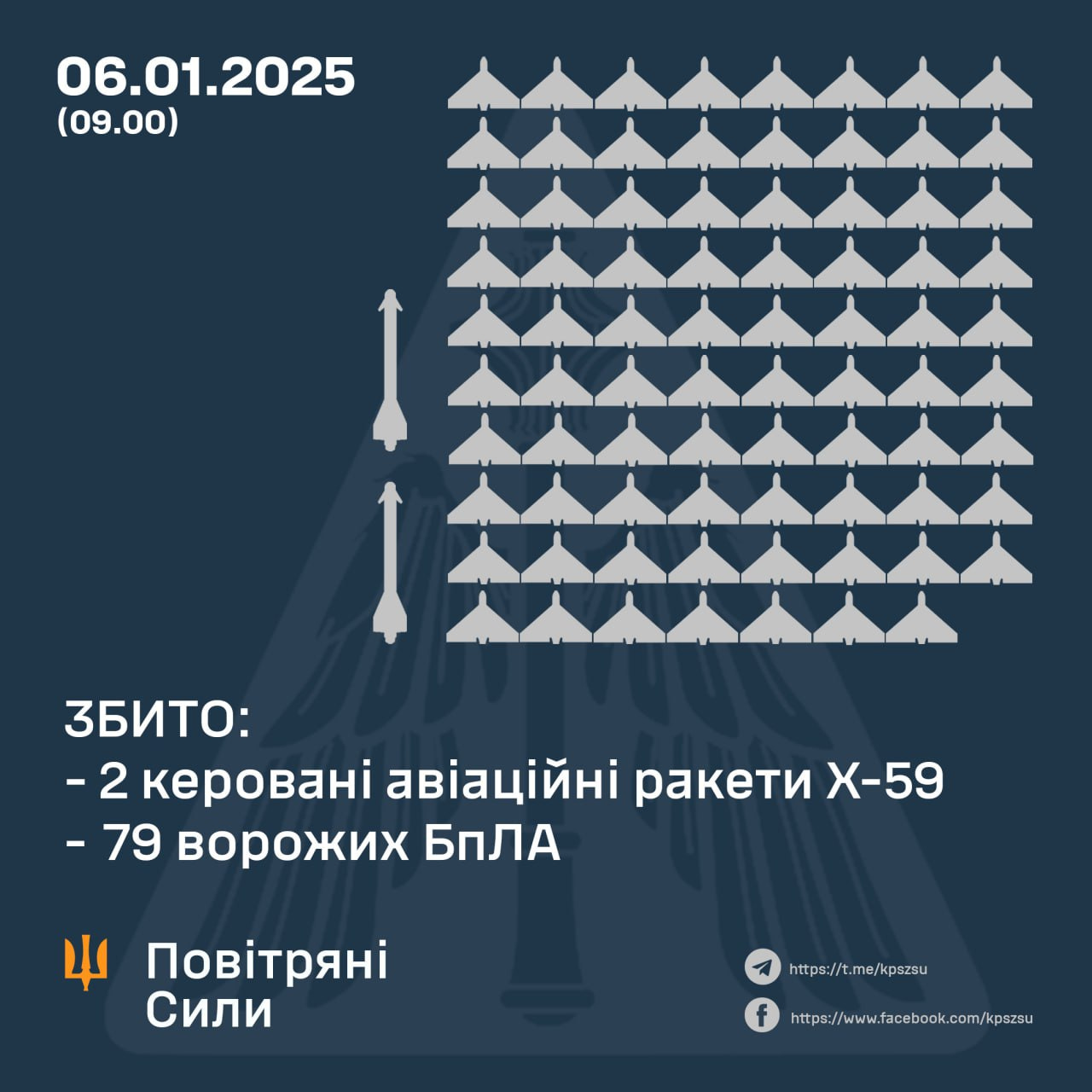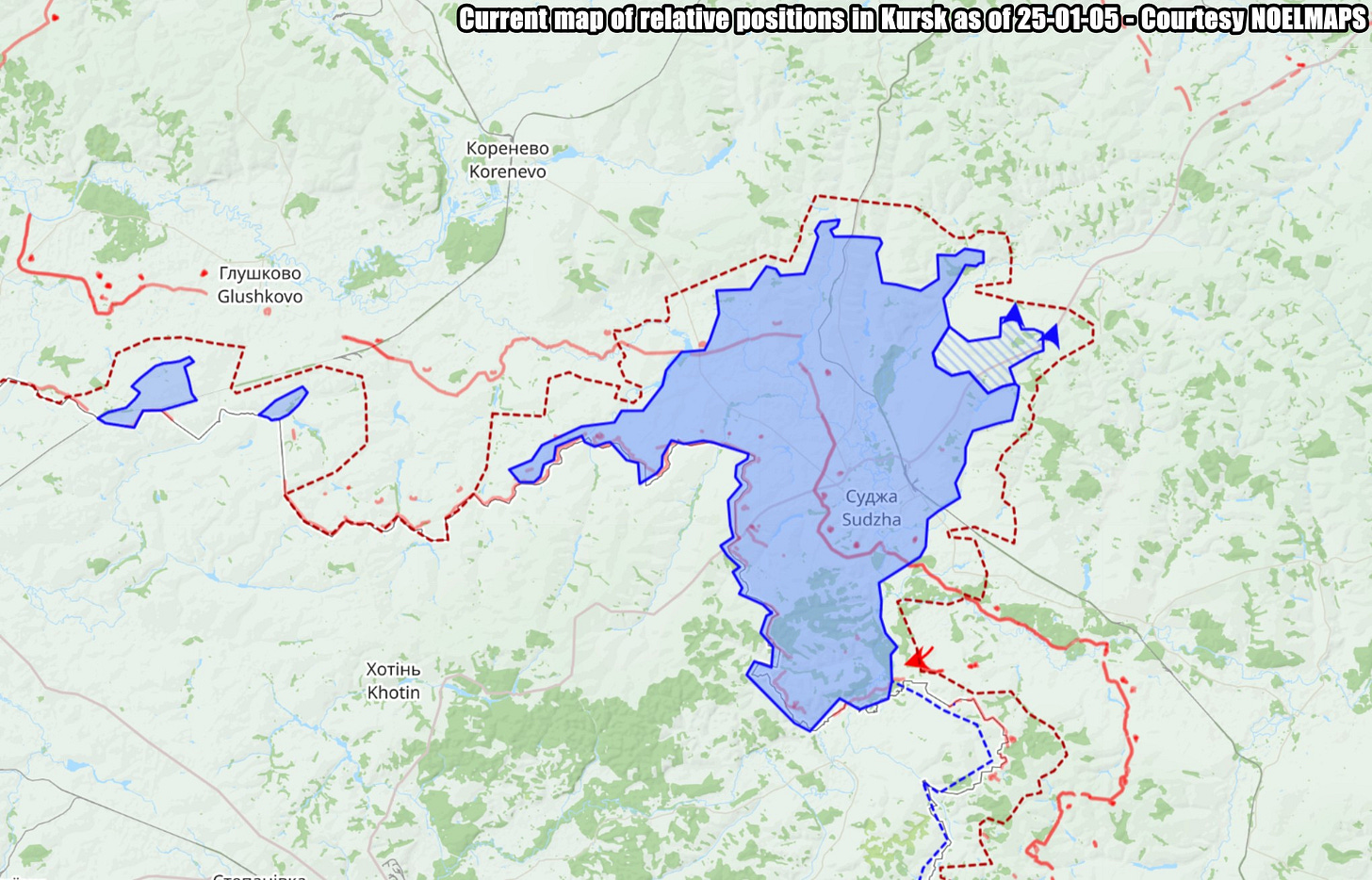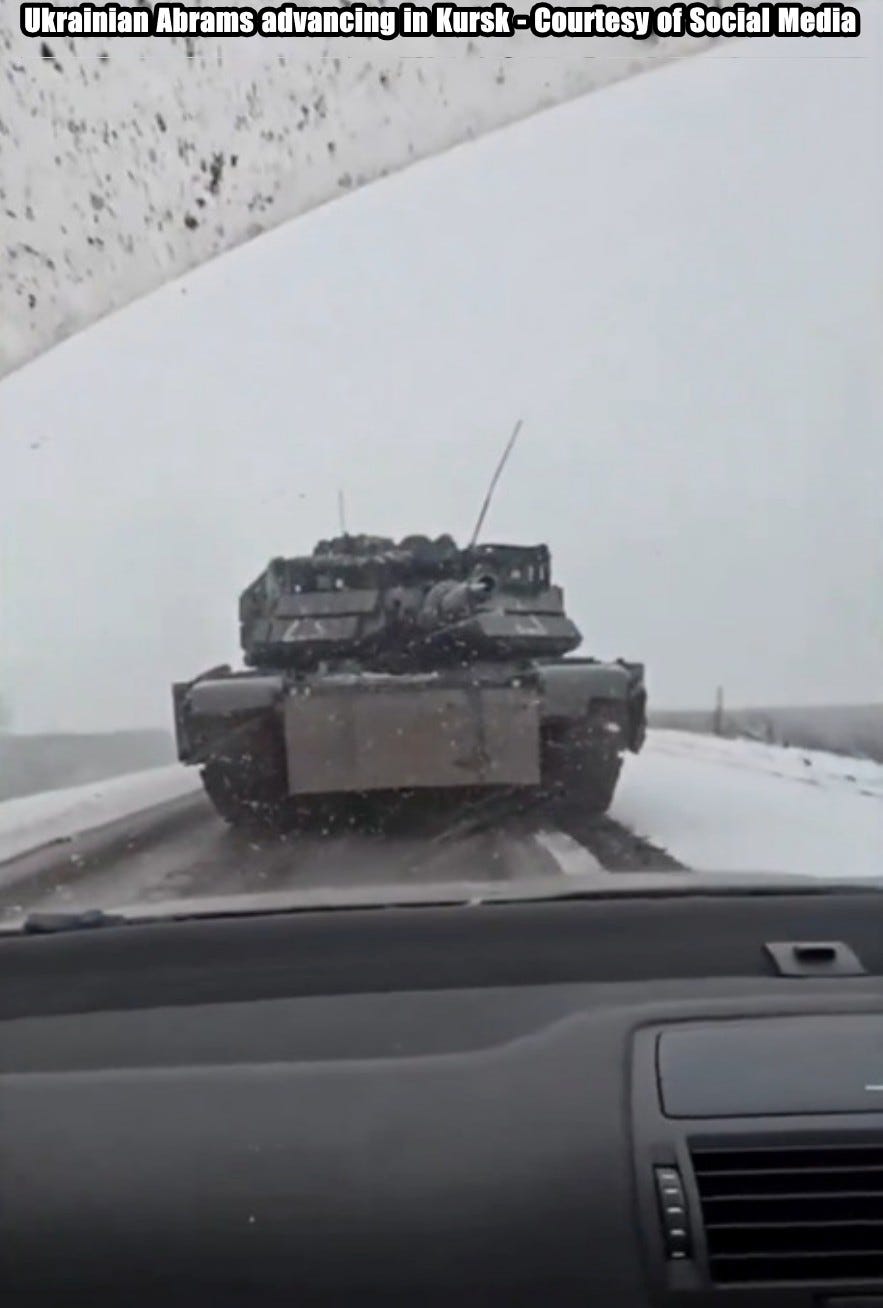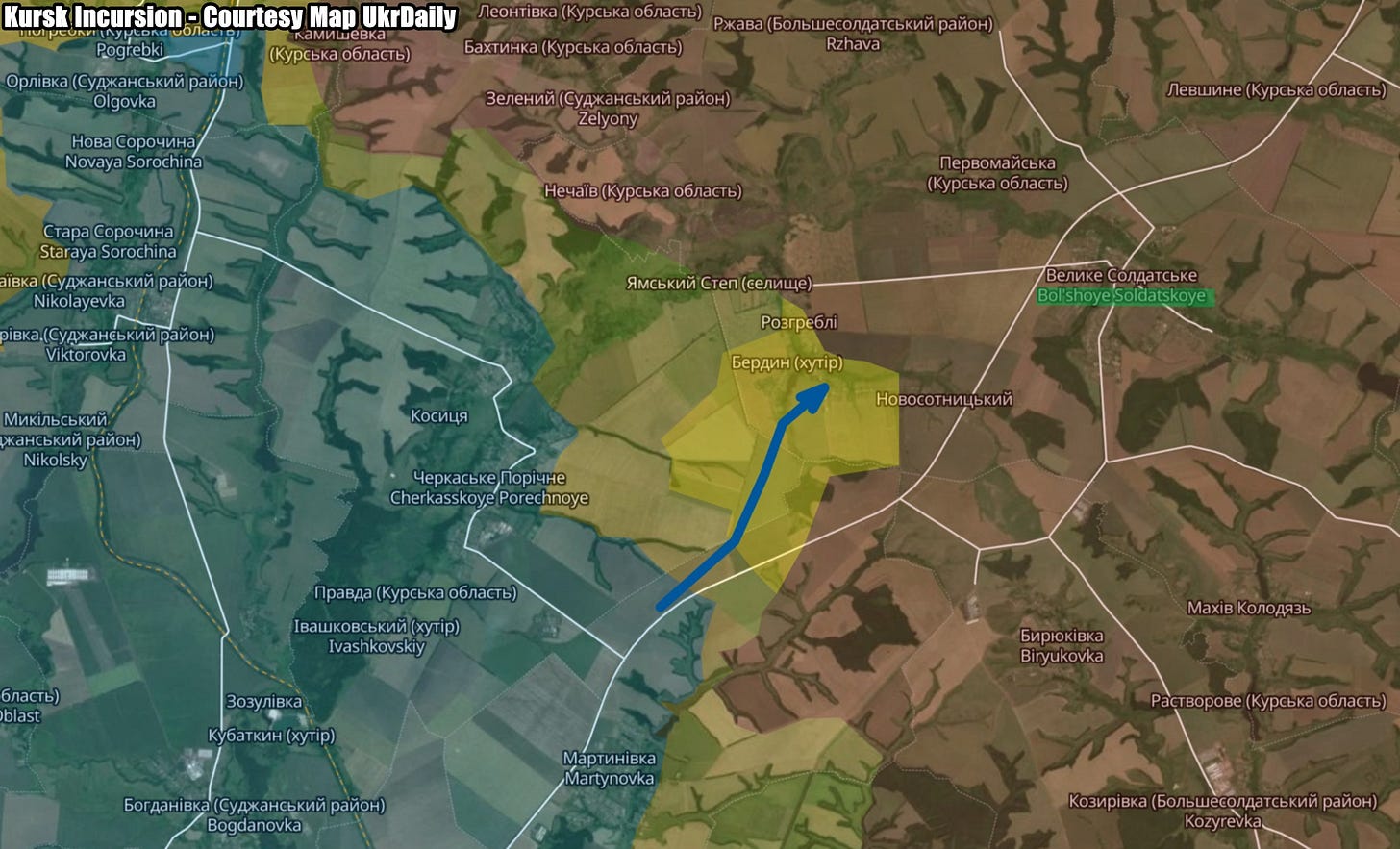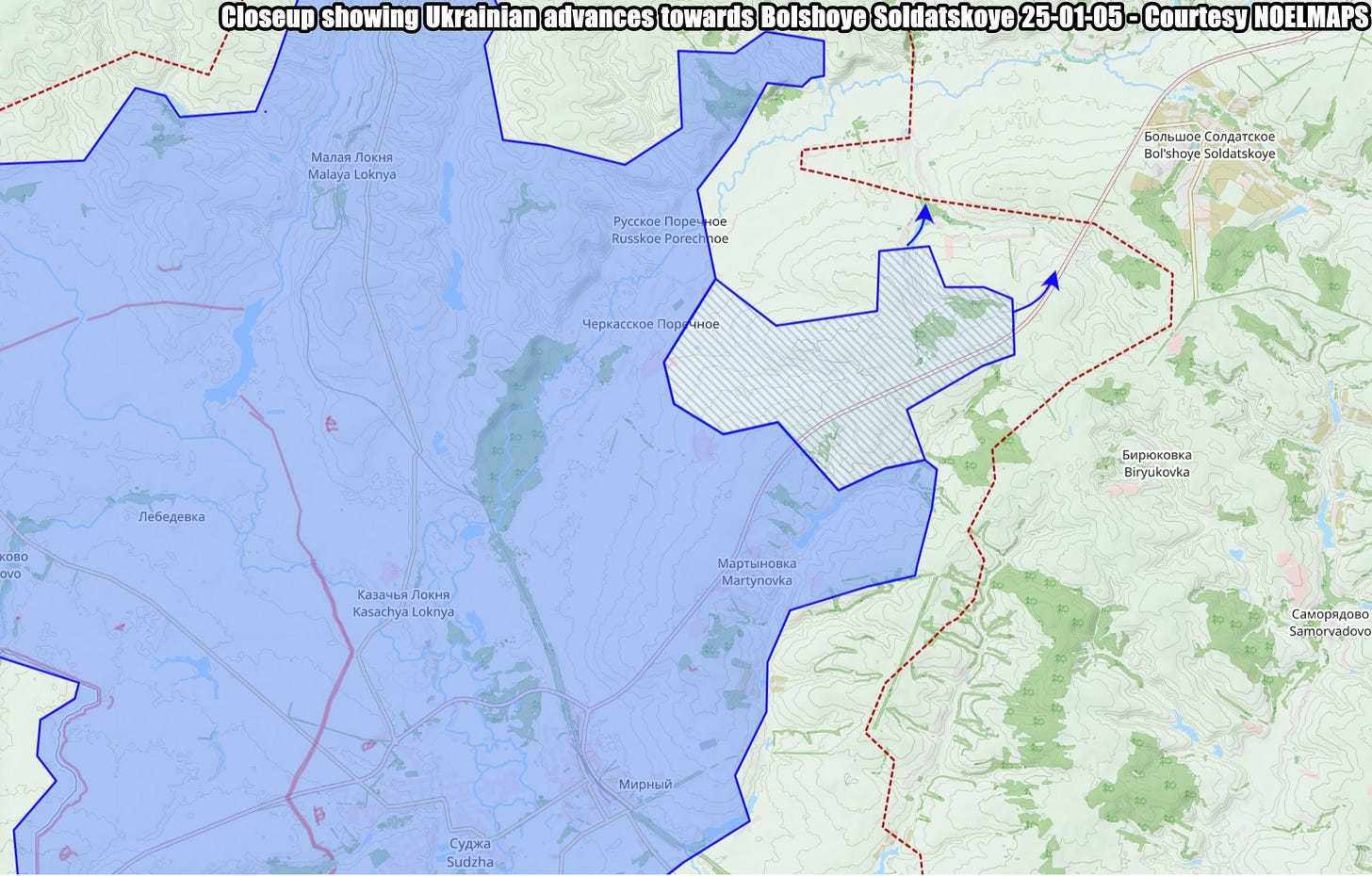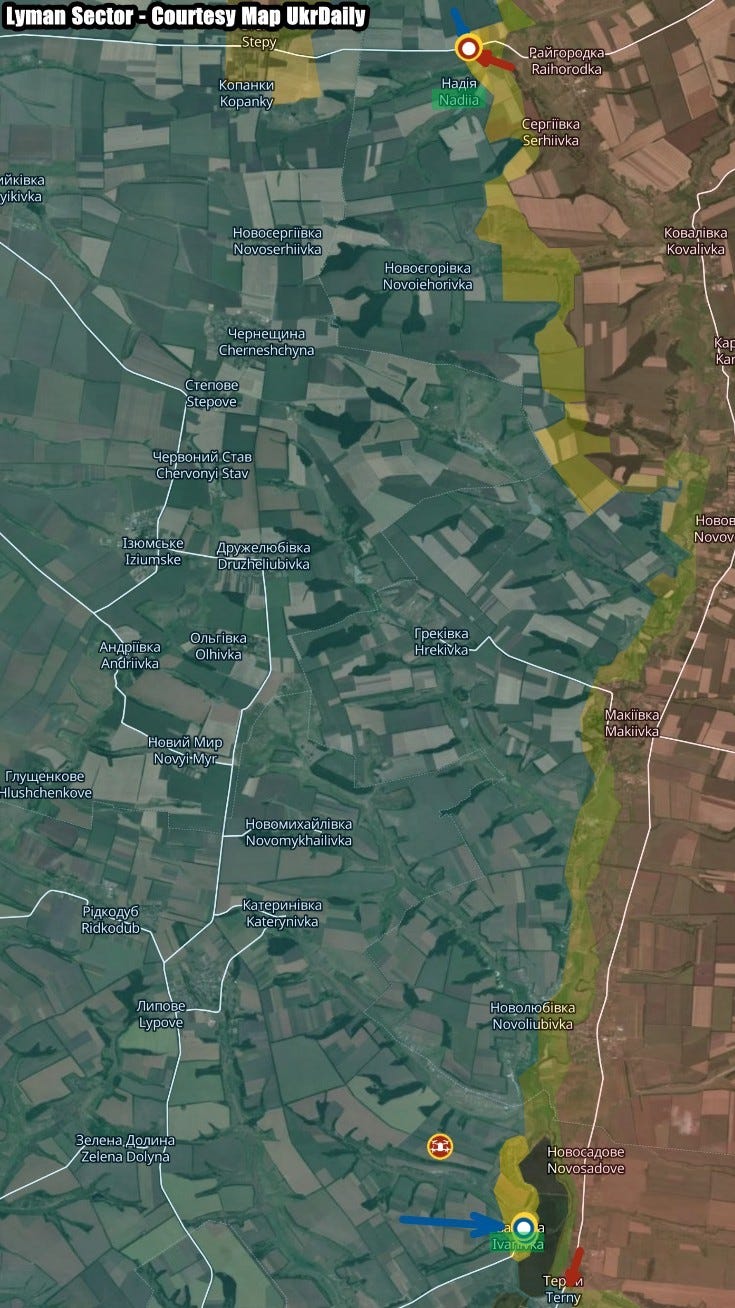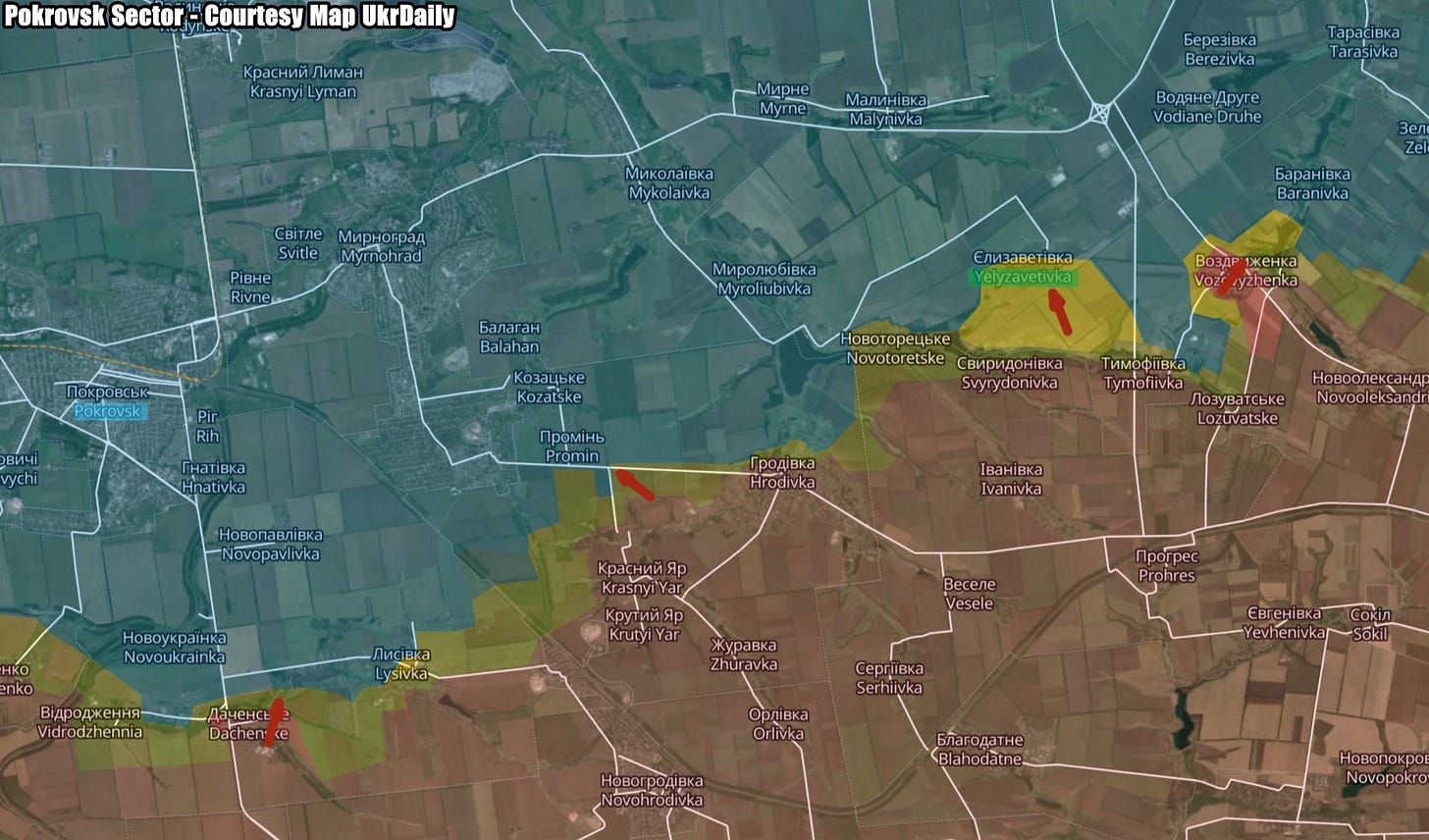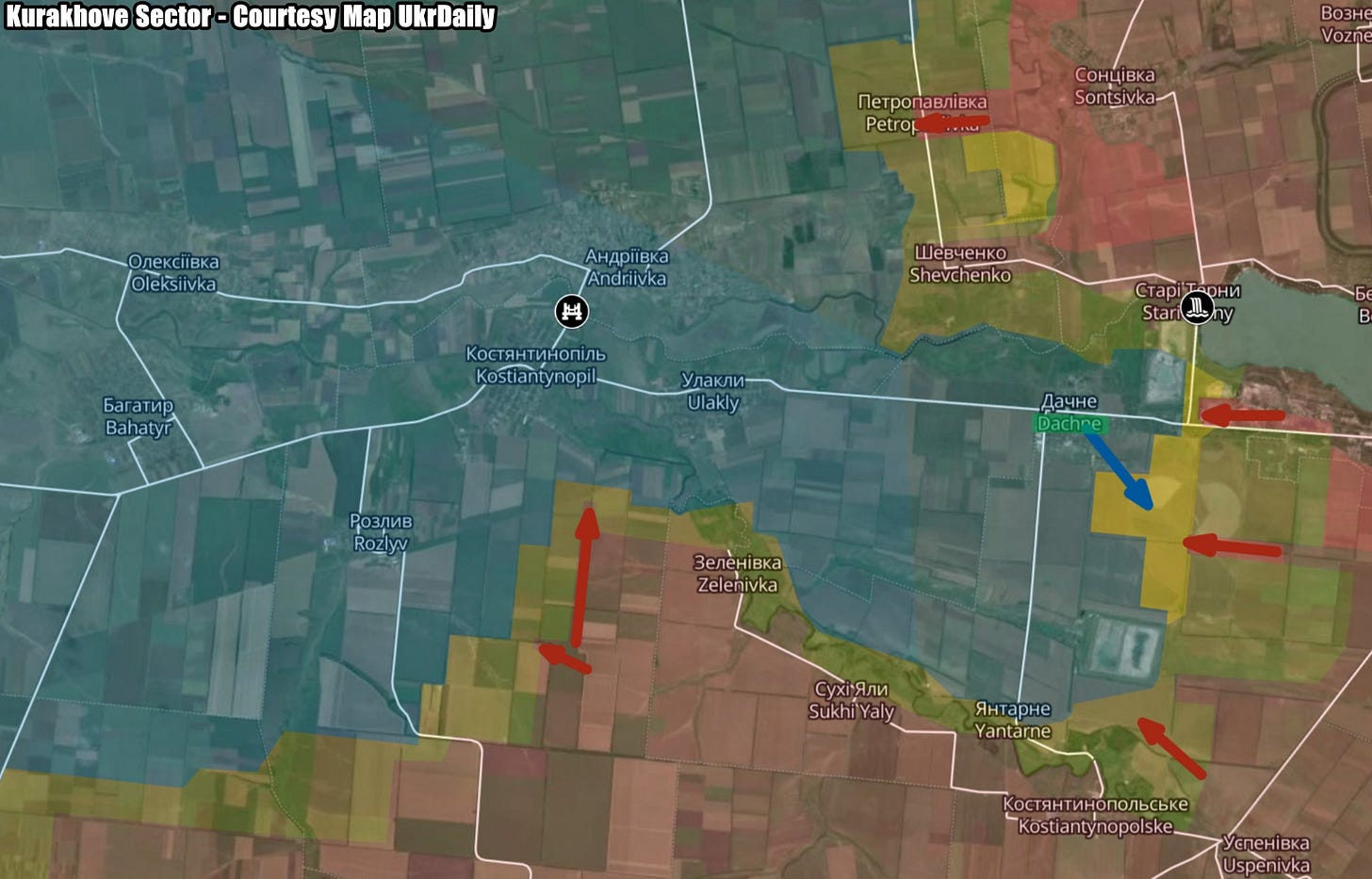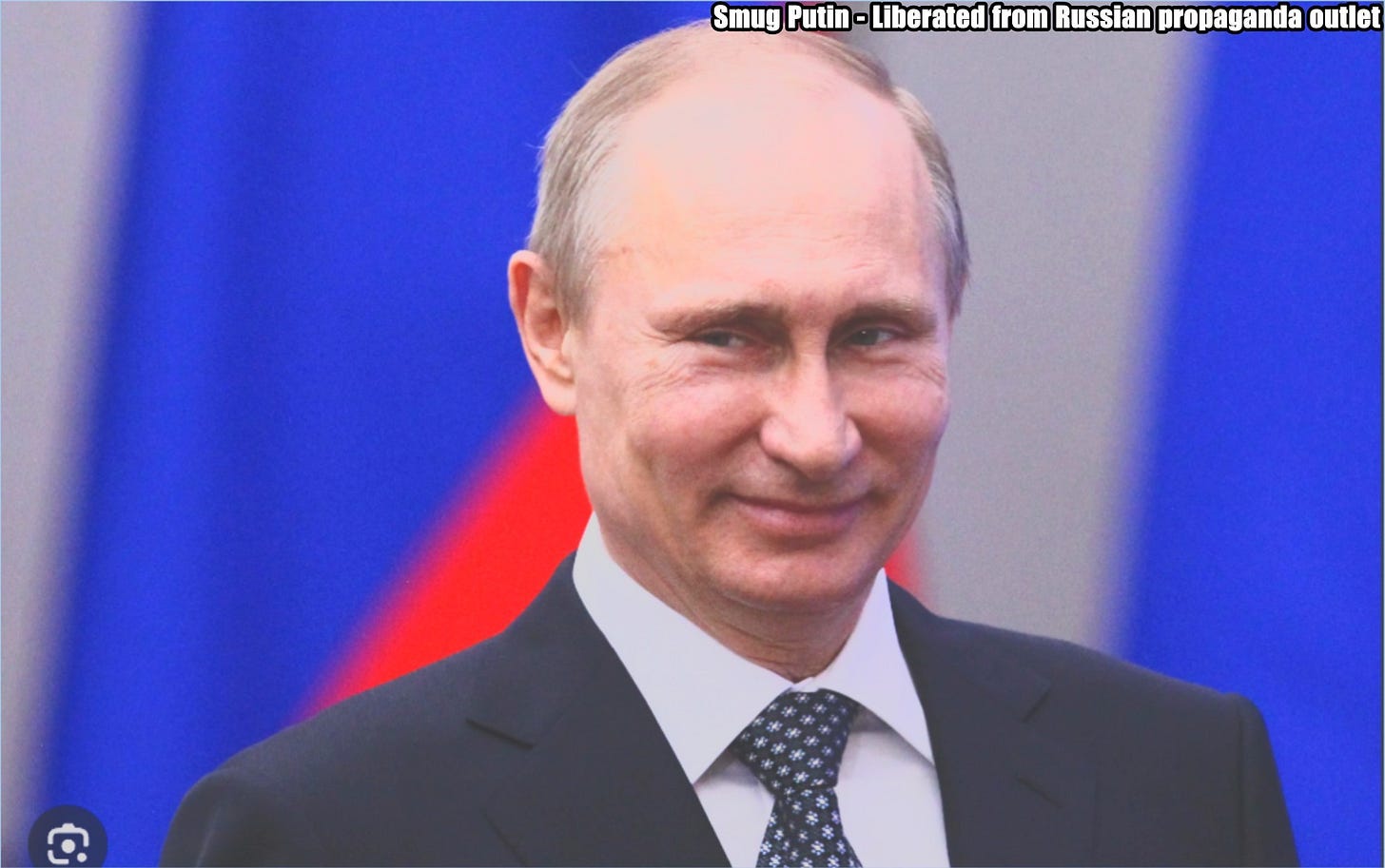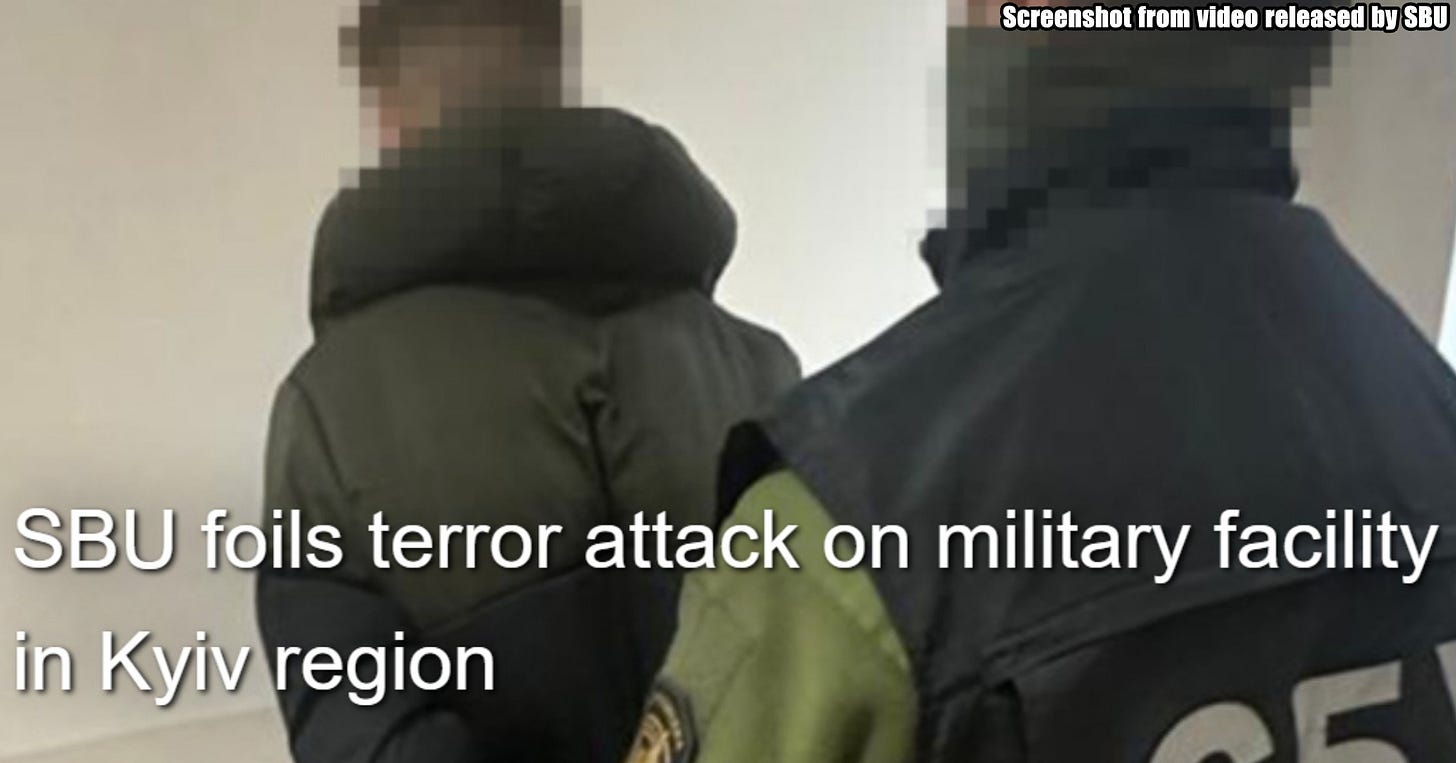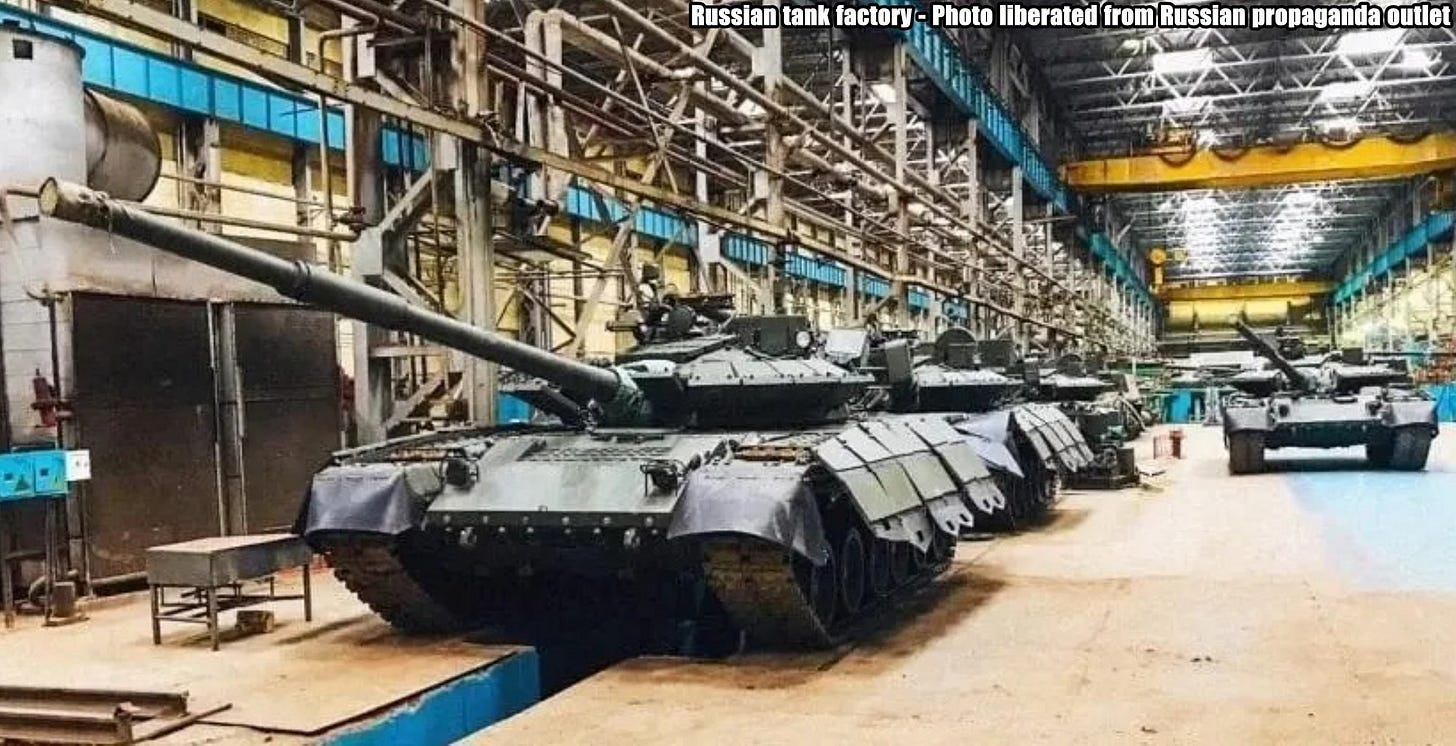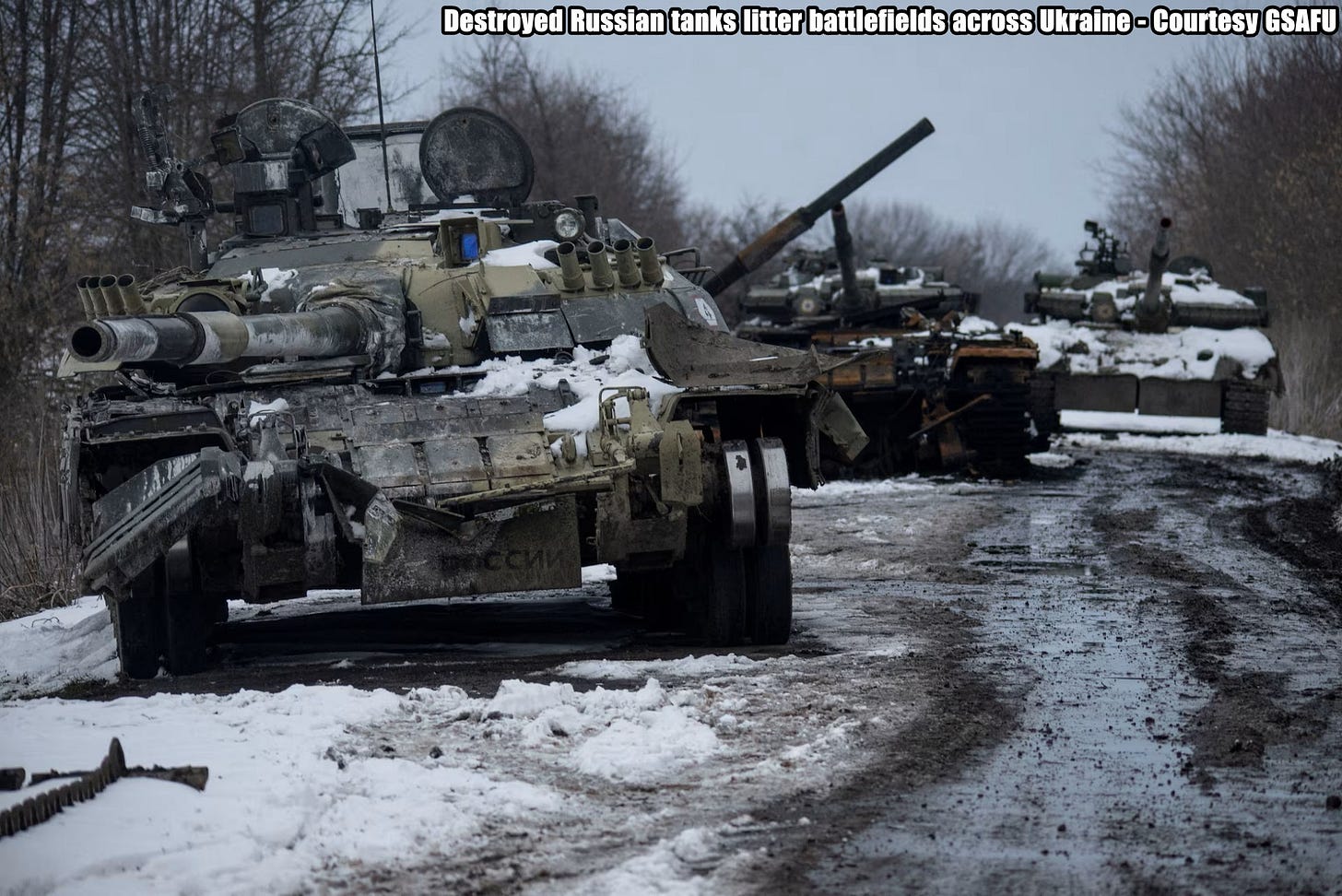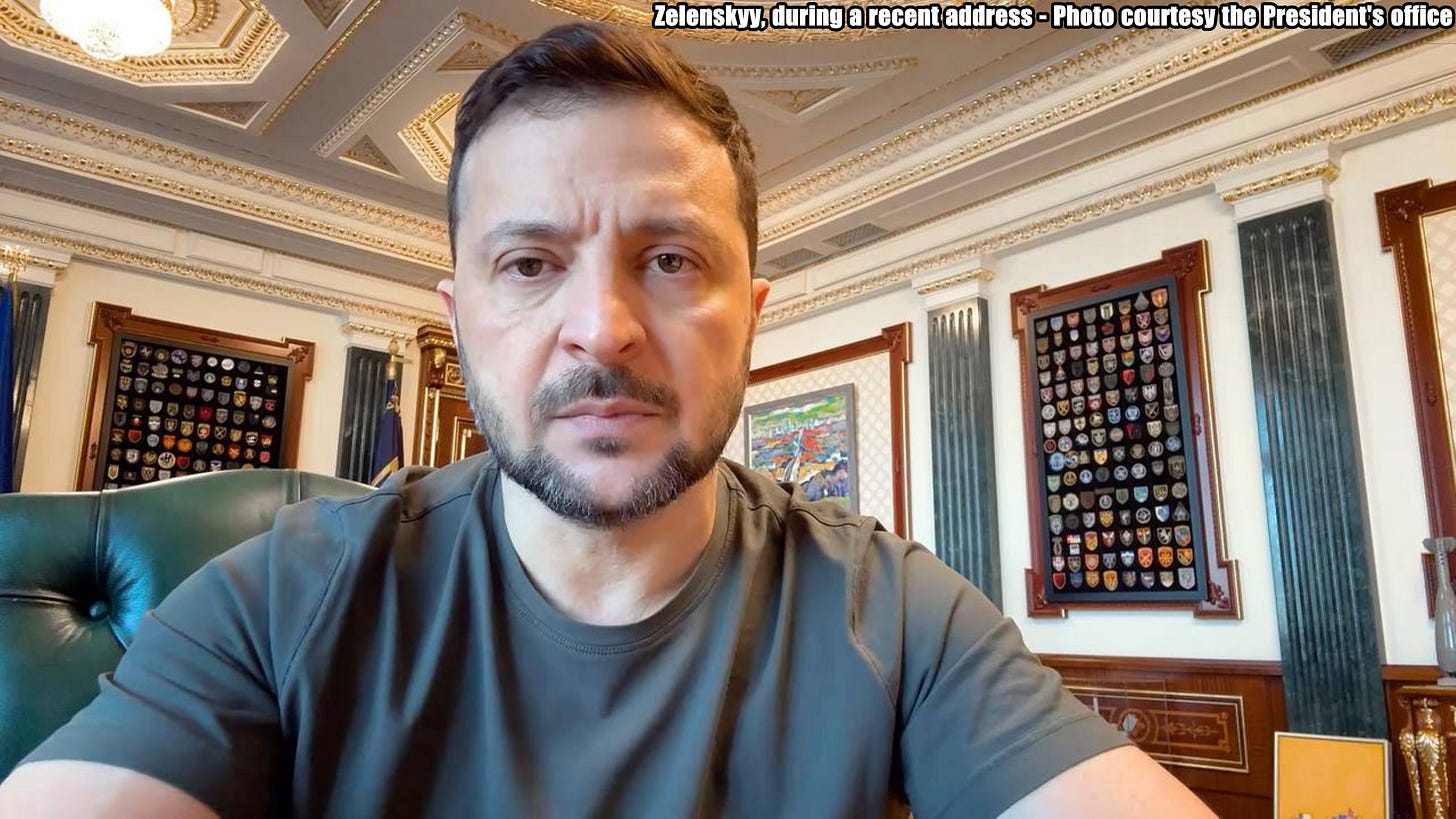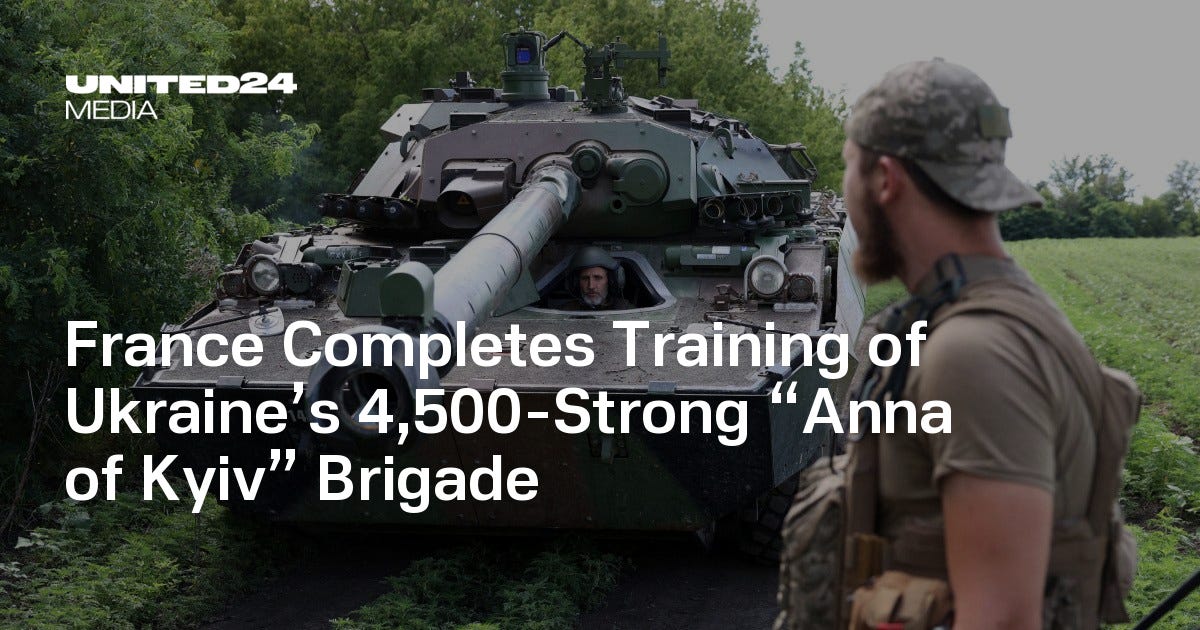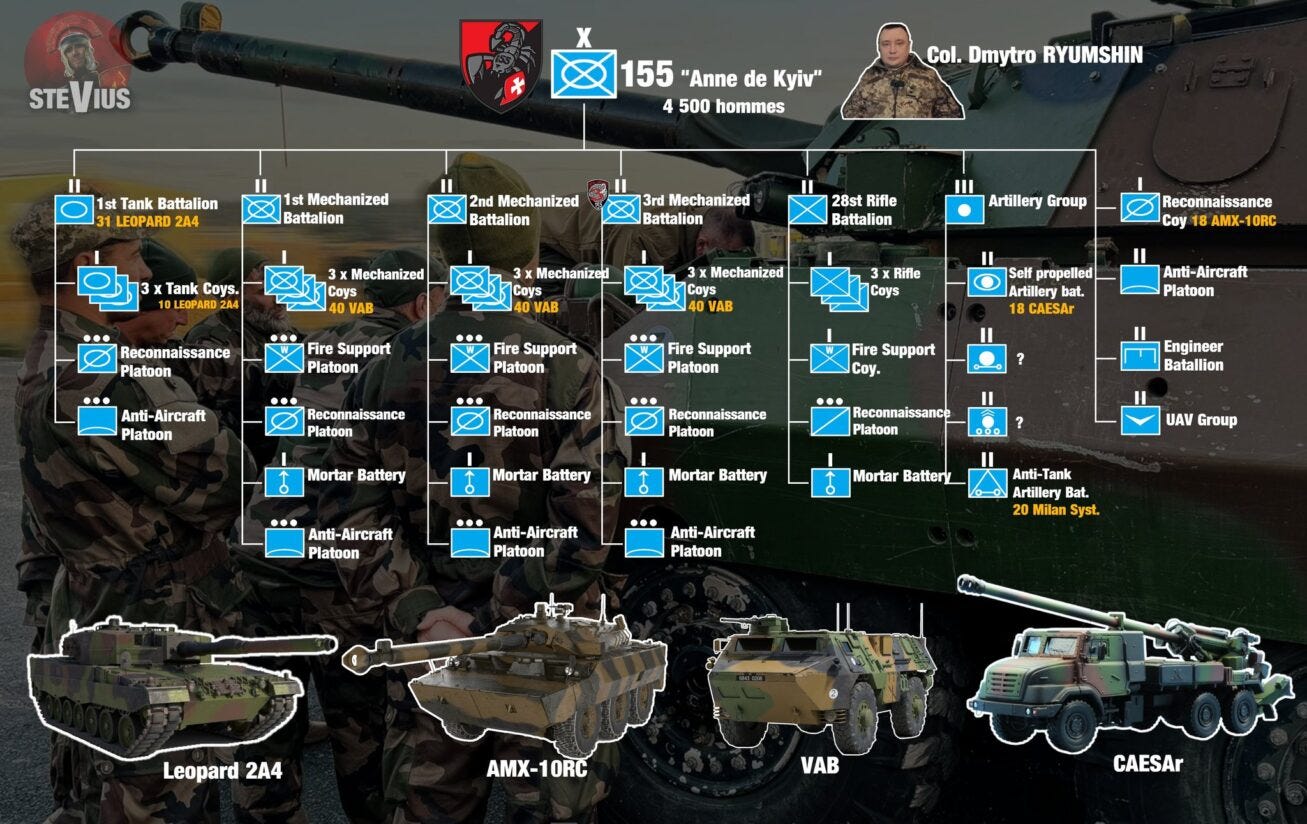Slava Ukraini! In early 2022 I began a Telegram channel aggregating news from a number of sources daily on the war in Ukraine. In June 2023 I began providing a daily draft for the Ukraine War Brief Podcast collecting news from over 70 sources daily, which formed the basis of the script. While the Podcast no longer exists I have continued to make this Brief available for my followers here on Substack for those who wish to keep up with the news from the war.
All the latest news on the Russo-Ukraine War 6 days per week
ALONG THE CONTACT LINE
GSAFU Morning Report
The General Staff of the Armed Forces of Ukraine in its Operational Information update at 08:00 on Jan 06 stated that day 1048 of the full-scale invasion of the Russian Federation against Ukraine had begun.
The situation on the line of combat remains tense in some sectors. Ukrainian defenders continue to actively counteract the Russian aggressor, causing them losses in personnel equipment and technology. Exhausting the enemy along the entire front line and continuing to disrupt the plans of Russian occupiers to advance deeper into the territory of Ukraine.
During the past two days, 363 combat engagements took place. Over the past 48 hours, the enemy carried out 3 missile strikes, 109 air strikes, used more than 5,310 drones and more than 9,400 artillery strikes across the positions of Ukrainian forces and civilians.
-
Air Force Daily Report
61 ENEMY UAVS SHOT, 42 DRONES FAILED TO REACH THEIR TARGETS (LOCATIONALLY LOST)
➖➖➖➖➖➖➖➖➖
On the night of January 5, 2025 (from 7:00 p.m. on January 4), the enemy attacked with 103 Shahed attack UAVs and simulator drones of various types from the directions of Bryansk, Millerovo, Orel - Russia.
The air attack was repelled by aviation, anti-aircraft missile troops, electronic warfare units, and mobile fire groups of the Air Force and Defense Forces of Ukraine.
As of 09:00, it has been confirmed that 61 Shahed attack UAVs and other types of drones have been shot down in Poltava, Sumy, Kharkiv, Kyiv, Chernihiv, Cherkasy, Dnipropetrovsk, Zhytomyr, and Khmelnytskyi regions. No hits were recorded.
42 enemy drones-simulators - lost in location (without negative consequences).
Several private houses were damaged in the Kharkiv region due to the fall of a hit attack UAV. The injured are being provided with assistance.
2 GUIDED AIRCRAFT MISSILES AND 79 ENEMY UAVS WERE SHOT, 49 DRONES DID NOT REACH THEIR TARGETS (LOCATIONALLY LOST)
➖➖➖➖➖➖➖➖➖
On the night of January 6, 2025 (from 18:00 on January 5), the enemy attacked with two Kh-59 guided aircraft missiles from the southern direction and 128 Shahed attack UAVs and simulator drones of various types from the directions of Bryansk, Millerovo, Orel, Kursk, Primorsko-Akhtarsk - Russia.
The air attack was repelled by aviation, anti-aircraft missile troops, electronic warfare units, and mobile fire groups of the Air Force and Defense Forces of Ukraine.
As of 09:00, the downing of two Kh-59 guided aircraft missiles and 79 Shahed attack UAVs and drones of other types was confirmed in Mykolaiv, Poltava, Sumy, Kharkiv, Kyiv, Chernihiv, Cherkasy, Dnipropetrovsk, Zhytomyr, Kirovohrad and Vinnytsia regions. No hits were recorded.
49 enemy drones-simulators - lost in location (without negative consequences).
Due to the fall of downed enemy drones, there is damage to buildings of enterprises, institutions and private houses in Chernihiv, Sumy, Cherkasy, Poltava and Kyiv regions. No victims or injuries have been reported.
The Russian Border Incursion
The Institute for the Study of War (ISW), a US based think tank, in its Jan 5 Russian Offensive Campaign Assessment reported that Ukrainian forces resumed offensive operations in at least three areas within the Ukrainian salient in Kursk Oblast and made tactical advances on Jan 5. Russian sources claimed that Ukrainian forces conducted multiple roughly company-sized mechanized assaults in the Berdin-Novosotnitsky direction (northeast of Sudzha) in three waves of attack using roughly a battalion's worth of armored vehicles.
Russian sources claimed that Ukrainian forces also intensified offensive operations in the direction of Leonidovo (southeast of Korenevo) and conducted a reinforced platoon-sized mechanized assault near Pushkarnoye (east of Sudzha). Geolocated footage published on Jan 5 indicates that Ukrainian forces advanced in fields southwest and south of Berdin and entered the southern part of the settlement.
Russian milbloggers published updated maps of the Kursk area of operations that indicate that Ukrainian forces also occupy Cherkasskoye Porechnoye, Martynovka, and Mikhaylovka (all northeast of Sudzha and southwest of Berdin) as of Jan 5 and reported that Ukrainian forces recently entered Novosotnitsky (just east of Berdin); and advanced in fields west of Yamskaya Step (immediately northwest of Berdin) and west of Novaya Sorochina (north of Sudzha and northwest of Berdin).
Russian milbloggers reported that Ukrainian forces also conducted offensive operations near Nikolskiy and Alexandriya (east and southeast of Leonidovo, respectively) and north of Russkaya Konopelka (east of Sudzha) towards Pushkarnoye in small infantry groups but did not provide details about the extent of any possible Ukrainian advances in these areas. Russian milbloggers largely expressed concern that the renewed Ukrainian effort in Kursk Oblast may be a diversionary effort and claimed that it is too early to determine whether these operations in Kursk could be part of a future main effort.
New Ukrainian Offensive in Russia’s Kursk Oblast.
Grumpy Here - On the night of Jan, 3 rumours began of a new Ukrainian offensive commencing, there was at that time no information on the scale of direction of the attack. Today, information has become somewhat clearer.
On Jan 4 BBC, Reuters and The Kyiv Independent all confirmed the news. Most of the information released to the press is from the Russian side, as usual Ukraine is being tight lipped in the early phases of an operation.
There are two interesting pieces of information that can be gleaned from Russian reports:
The first is that according to Russian sources Ukrainian forces broke through Russian defensive lines northeast of Sudzha.
The size of the operation is unclear, but the Russian milbloggers reported that the initial breaching force consisted of a mine clearing vehicle, 2 tanks 12 IFVs and a number of paratroopers.
Russian sources have claim that they now have the situation under control, however that may just be typical Russian boasting.
Maps released by the normally reliable NOELREPORTS show Ukrainian forces have advanced significantly towards the town of Bolshoye Soldatshoye.
A second possibly more interesting piece of the puzzle came from influential Russian milblogger FIGHTERBOMBER who claimed that Ukraine introduced a powerful new EW device during this offensive that caused all the Russian drones in the area to fall out of the sky at once.
Russian sources concerned with Ukraines ability to integrate EW and long range strikes with ground operations.
The Institute for the Study of War (ISW), a US based think tank, in its Jan 5 Russian Offensive Campaign Assessment reported that Russian sources expressed concern about the Russian military's ability to react to Ukraine's ongoing combined arms efforts to integrate electronic warfare (EW) and long-range strike capabilities with ground operations. Several Russian milbloggers claimed on Jan 5 that Ukrainian EW interference during Ukrainian assaults in Kursk Oblast prevented Russian forces from operating drones in the area, degrading Russian forces’ ability to defend against Ukrainian mechanized attacks.
Russian milbloggers claimed that drones with fiber optic cables are one of the few Russian drone variants that consistently resist Ukrainian EW countermeasures, although some Russian milbloggers claimed that Russian forces were able to use some first-person view (FPV) and Lancet drones. Russian officials claimed on Jan 5 that Russian forces downed three unspecified Ukrainian missiles over Kursk Oblast, suggesting that Ukrainian forces may be attempting to integrate longer-range strike capabilities with ground operations and tactical EW systems.
A Russian milblogger claimed that Ukrainian forces conducted HIMARS strikes near Bolshoye Soldatskoye and other unspecified areas in Kursk Oblast to prevent Russian forces from deploying reinforcements, artillery systems, and drone operators.
Widespread Russian concern over Russia's ability to respond to improved Ukrainian EW technology and long-range strike capabilities indicates that Russian forces may be struggling to quickly adapt to Ukrainian battlefield innovations. Reports that Ukrainian forces are using long-range fires to interdict Russian rear areas and EW to degrade Russian drones in support of Ukrainian mechanized advances indicate that Ukrainian forces operating in Kursk are employing more effective combined arms tactics.
The Khortytsia operational-strategic group
(Responsible for the northeastern part of Ukraine. )
Lyman Sector: In this sector over the weekend Russian forces advanced slightly towards Nadiya and Ivanivka, in both cases Ukrainian forces have counterattacked to regain lost positions.
The Tavria operational-strategic group
(Responsible for the central-eastern and southeastern part of Ukraine.)
Pokrovsk Sector: There were 50 combat engagements in this sector over the previous day. Russian forces advanced marginally through open fields towards.
Kurakhove Sector: Russian forces advanced southwest of Kurakhove and Ukrainian forces countered by attacking from the Dachne area.
The Odesa operational-strategic group
(Responsible for Kherson, Qırım, (also known as Crimea) and the Black Sea.)
Nothing major to report.
TEMPORARILY OCCUPIED TERRITORIES
Nothing major to report.
THE HOME FRONT
Zelenskyy says Putin doesn't love his country.
Russian President Vladimir Putin does not love his country and people as he is sending Russia's youth to die in his wars of aggression, President Volodymyr Zelenskyy said in an interview with U.S. podcaster Lex Fridman released on Jan. 5. The Kyiv Independent reports.
"He does not love his people. He loves only his inner circle," Zelenskyy said in response to Fridman's suggestion that Putin is a "serious person who loves his country."
"What is his country? He happened to consider Ukraine his country," the president responded in the three-hour-long interview, pointing out that Putin had previously also launched a destructive war against Chechnya, now a constituent republic of the Russian Federation.
Putin rose to power during the Second Chechen War in 1999-2000, in which Russia forcibly subjugated the region and seized its capital, Grozny, after a devastating siege.
"Who are the Chechens? A different people: Another faith… Another language. One million people eliminated…. How did he kill them – with love?" Zelenskyy asked rhetorically.
Ukraine's head of state also stressed that Russia's all-out war against Ukraine resulted in 780,000 of its soldiers killed or wounded, adding that Putin "calls them all Russians, even those who don't know how to speak Russian, on his territory of Russia, everything they've enslaved."
"He's (Putin) sending 18-year-boys (to die in war)... It's not that the fascists came to his country, and he needs to defend it. He came to ours, and he sends them," Zelenskyy continued, providing other examples of Moscow's wars and military interventions in Syria, Chechnya, Georgia, and Africa.
Though the exact Russian losses in the full-scale invasion are difficult to establish with certainty, The Economist wrote that they already outpace Moscow's battlefield losses in all of its post-1945 wars combined.
SBU foils Russian attack on military facility in Kyiv region.
Counterintelligence operatives detained four members of a Russian human intelligence network, including a minor, who were planning to set off an explosive device at a military facility in Kyiv region. Ukrinform reports citing the SBU press office.
As the investigation learned, the improvised explosive device was put in a tactical backpack, which was supposed to be delivered to the facility by a teenager sporting a Ukrainian military uniform.
The Russians tracked the suspect’s movement online, intending to detonate the explosive device as soon as the young man entered the targeted building.
At the same time, the minor was unaware of his handler’s plot to use him as a suicide bomber, being told that the explosive will go off once he leaves the building.
The SBU counterintelligence foiled Russia’s plans and took measures to prevent the attack. As a result, the underage terrorist and three other Russian assets were apprehended.
The investigation learned that the media objective of the terrorist act was to provoke conflict among the Ukrainian military by creating an appearance of a soldier blowing up others as a sign of protest. The four suspects acted separately from each other, having the same Russian handler.
One of the exposed assets is a 16-year-old student from Kirovograd region, who received from the Russians the coordinates of the cache where he took the explosives and military uniform.
Another member of the network is a 19-year-old young man who is believed to have brought the explosives and uniform from one cache to another, where the 16-year-old suspect retrieved them.
The “initial cache” was set up by the two residents of Vinnytsia region. Following video instructions of their Russian handlers, they produced an improvised explosive device and hid it in a designated location.
During the raids, law enforcers seized from one of the suspects 1.5 kg of explosive mixture for IED production.
The SBU pressed charges against the suspects, including of treason committed under martial law and illegal handling of explosives.
The detainees shall be held in remand without bail, facing life in prison if found guilty in court.
RUSSIAN WORLD
Russian armoured vehicle losses, 3 times those of previous years, are unsustainable.
The Institute for the Study of War (ISW), a US based think tank, in its Jan 4 Russian Offensive Campaign Assessment reported that Ukrainian forces reportedly destroyed or damaged over 3,000 Russian tanks and almost 9,000 armored vehicles in 2024 as Russia continues to accrue vehicle losses that are likely unsustainable in the medium-term.
Data from the Ukrainian General Staff indicates that Ukrainian forces destroyed or damaged 3,689 tanks, 8,956 infantry fighting vehicles (IFVs), 13,050 artillery systems, and 407 air defense systems between Jan 1, 2024 and Jan 1, 2025. Russian forces reportedly lost at least 197 tanks, 661 armored personnel carriers (APCs), and 65 artillery systems larger than 100mm throughout the frontline during a period of intensified offensive operations in Donetsk Oblast in September and October 2024 and likely sustained a higher rate of tank and armored vehicle losses in June and July 2024 when Russian forces were conducting mechanized assaults in western Donetsk Oblast several times a week that often resulted in armored vehicle losses.
Russia's current armored vehicle and tank production rates indicate that such losses will likely be prohibitive over the longer term, particularly as Russia continues to dip into its Soviet-era stocks. Ukrainian military observer Kostyantyn Mashovets stated in February 2024 that the Russian defense industrial base (DIB) can produce 250-300 "new and thoroughly modernized" tanks per year and can repair roughly 250-300 additional damaged tanks per year, far below Ukraine's estimate of 3,600 Russian tanks lost in 2024.
The British International Institute for Strategic Studies (IISS) think tank also reported in February 2024 that Russia is likely able to sustain its rate of vehicle losses at that time (over 3,000 armored fighting vehicles including tanks, armored personnel carriers, and infantry fighting vehicles annually as of 2023 and nearly 8,800 between Feb 2022 and Feb 2024) for at least two to three years (until about Feb 2026 or 2027) by mainly refurbishing vehicles from Soviet-era storage facilities. A social media source tracking Russian military depots via satellite imagery shared an updated assessment of Russian tank and armored vehicle storage facilities on December 22 and assessed that Russian forces have 47 percent of their pre-war tank reserves, 52 percent of pre-war infantry fighting vehicle reserves, and 45 percent of pre-war armored personnel carrier reserves remaining in storage as of a recent unspecified date. The social media source noted that Russian forces have used most of their newer T-90 and T-80 tanks but still have a majority of their older tanks in storage, although some of these tanks have likely been heavily degraded by weather and time. It appears increasingly unlikely that the Russian military can sustain its current annual rate of almost 9,000 armored vehicle losses through 2025.
This loss rate is nearly three times the annual loss rate of the first two years of the war according to IISS, suggesting that the Feb 2024 IISS estimate that Russia can sustain its vehicle losses through 2025 and possibly 2026 is no longer valid.
Russian forces have reportedly been using fewer armored vehicles in assaults in the most active areas of the frontline in recent weeks, possibly in order to conserve these vehicles as Soviet stocks dwindle. Ukrainian military sources have recently noted that Russian forces have been using fewer armored vehicles and conducting fewer mechanized assaults in the Kurakhove direction after suffering significant vehicle losses in October and November 2024. The spokesperson of a Ukrainian brigade operating in the Kurakhove direction stated on January 3 that Russian forces have switched to mainly using infantry to conduct assaults in the area over the past few weeks and are only using armored vehicles as fire support for infantry assaults.
The New York Times reported on December 31 that a Ukrainian lieutenant colonel stated that Russian forces are increasingly using electric scooters, motorcycles, and all-terrain vehicles (ATVs) during assaults in eastern Ukraine, possibly as part of ongoing Russian efforts to offset armored vehicle losses. Russian attacks near more mid-sized, urban settlements such as Kurakhove and Pokrovsk may also be less conducive to mechanized assaults than the small settlements and open fields where Russian forces advanced in most of 2024. Russian forces may be using fewer armored vehicles in the Kurakhove and Pokrovsk directions if the Russian military is struggling to reequip frontline Russian units and formations and if Russian military command does not want to withdraw Russian units for rest and reconstitution and risk further slowing Russian advances in high-priority frontline sectors.
INTERNATIONAL NEWS
Ukraine has received less than half of US assistance allocated during full-scale war.
Ukraine has not received even half of the $177 billion the U.S. allocated to support Kyiv throughout the full-scale war, President Volodymyr Zelenskyy said in an interview with U.S. podcaster Lex Fridman released on Jan 5. The Kyiv Independent reports.
Zelenskyy implied that this development may have been linked to corruption or lobbying on the side of U.S. companies. Ukraine's head of state said this in response to Fridman's question about corruption concerns in Ukraine.
The U.S. has become Ukraine's top supporter, providing the largest amount of military assistance to resist Russian aggression. Voices critical of Washington's support have often cited corruption risks and dangers of the illicit arms trade, though U.S. watchdogs have closely monitored the assistance.
While acknowledging corruption in Ukraine, Zelenskyy said that his country works hard to combat it through the "most complex" anti-corruption system in Europe. He also said that what would be called "corruption" in Ukraine might be called "lobbyism" elsewhere.
"If we had $177 billion and if we get the half, where is the second half? If you find the second half, you will find corruption," Zelenskyy commented in the wide-ranging three-hour interview.
Zelensky provided an example of him allegedly unsuccessfully appealing to Washington to bring in U.S. arms using Ukraine's own fleet of cargo planes not to pay for the transport.
"No. I didn't get this opportunity. My jets stayed put, and the U.S. jets, cargo jets moved these weapons. But everywhere you have to spend money," Zelenskyy added, saying that Ukraine could have spent this money to buy more arms instead of paying for expensive transport to U.S. companies.
"Is this corruption or not? Or lobbyism?" the president asked, saying that he has been reluctant to talk about such causes so as not to cause a scandal that could lead to the halt of aid.
The president stressed that Ukraine does not profit from the war and that such claims stem from Russian propaganda, adding that Ukrainian authorities strictly punish anybody who attempts to profit from foreign military aid.
Ukraine has made strides to combat corruption since the EuroMaidan Revolution in 2014, but civil society groups and activists have raised the alarm about the anti-graft efforts slowing down during the full-scale war.
MILITARY & TECH
SBI launches investigation into mass desertions in 155th "Anna of Kyiv" brigade
The State Bureau of Investigation has launched an investigation into the abuse of power and desertion in the 155th mechanized brigade "Anna of Kyiv" following an investigation published in the media. Censor.NET reported on Jan 2 citing Interfax-Ukraine via the SBI's communications advisor Tetiana Sapian.
"The SBI is indeed examining the facts presented in the media within the framework of criminal proceedings initiated under Article 426-1 (abuse of power or official authority by a military person - ed.) and Article 408 (desertion - ed.) of the Criminal Code of Ukraine. The investigation is ongoing. It's too early to talk about any preliminary results," Sapian said.
On Jan 1 Censor.NET Editor-in-Chief Yurii Butusov outlined a number of facts about the circumstances of the formation and functioning of the 155th mechanized brigade "Anna of Kyiv", which entered the battle near Pokrovsk and suffered significant losses there.
According to him, the 155th Brigade faced a number of problems: 1,700 soldiers went AWOL before the first battle, the brigade commander was fired immediately after the battle, and one of the brigade's leaders died of a heart attack.
Butusov conducted a lengthy investigation to find out what exactly led to the significant losses among the brigade's personnel and equipment and the massive AWOL.
In October, the 155th Brigade left for training in France.1924 servicemen were sent there, of whom only 51 had more than a year of military service, 459 had up to a year of experience, and the majority, 1414, were just enlisted and served for less than 2 months, about 150 people were sent to France even without undergoing the basic general military training. About 50 military brigades fled to France.
The editor-in-chief of Censor.NET also reports that the brigade was not provided with the necessary weapons. In particular, the brigade has not received any drones from the state to perform combat missions. Also, according to Butusov, there were no electronic warfare systems. The brigade was supplied by volunteers.
In addition, all the 120 mm mortar shells produced by the Ministry of Strategic Industries that were given to the brigade were faulty.
The journalist accused the political and military leadership of the state of an ill-conceived PR stunt and called for liability.
Syrskyi orders to reinforce French-trained brigade with drones after reports of mismanagement
Commander-in-Chief Oleksandr Syrskyi ordered to boost Ukraine's 155th "Anna of Kyiv" Mechanized Brigade with drones after reports of desertion and mismanagement, The Kyiv Independent reported on Jan. 5.
"I paid special attention to building up the capabilities of the unmanned systems unit of the 155th Mechanized Brigade, as well as to the problematic issues that need to be resolved," Syrskyi said.
His remarks came following a media investigation that claimed that soldiers of the unit, now deployed near Pokrovsk, have suffered losses and went AWOL (absent without leave) in large numbers due to poor command and organization on Ukraine's side.
Sysrkyi's statement marks the first time that the military leadership mentioned the 155th Brigade, although without elaborating on the details of the scandal.
Yurii Butusov, the chief editor of the Censor.net, claimed on Jan. 4, citing the outlet's unnamed sources, that President Volodymyr Zelensyky held a meeting with the military and top officials and "took the investigation under his control."
The brigade is a flagship project under which NATO countries will help train new Ukrainian military formations and provide heavy equipment. The training of the 155th Brigade, named after an 11th-century Kyiv Rus princess and spouse of French King Henry I, was announced by French President Emmanuel Macron in June.
A Few Western Anti-Drone Systems Seemingly Just Made For Trials in Ukraine.
More and more manufacturers have adopted the idea of integrating air defense systems with unmanned platforms, and Ukraine could be the perfect proving ground. Defense Express reported on Jan 5
Nowadays, ground-based robotic systems on the battlefield are not as popular as aerial drones, but nonetheless, hundreds of wheeled and tracked robots have been purchased for the needs of the Armed Forces of Ukraine, with many already effectively utilized on the battlefields.
Most are made domestically, but Western-supplied systems are present as well: the Estonian THeMIS unmanned multirole platform is a well-known example, but more new interesting developments have been presented over the past few years that could be useful to Ukrainian forces while also benefiting the developers as a trial by fire in real combat conditions.
Late 2024, the German company Rheinmetall announced successful tests of a system from its Canadian branch: a short-range air defense system based on the Mission Master XT unmanned platform. It is armed with a Rheinmetall Fieldranger Multi remotely controlled weapon station with two Dillon Aero M134D miniguns, a radar, a target tracking system based on artificial intelligence, and more utilities. The declared range is 50 to 800 meters.
A similar counter-UAS system was demonstrated by the French company Soframe earlier in November. The basis was the 4×4 wheeled HE 441 all-terrain vehicle, either remotely operated or fully autonomous. This unmanned ground vehicle's selling points are smooth operation on difficult terrain, robust design, and modularity, making it flexible in various missions.
But the most interesting part is that this UGV was marketed mainly as a mobile air defense tool specifically against aerial drones. To excel in this task, the robot is equipped with a HELMA-P laser weapon manufactured by Cilas, a French company and a subsidiary of the Ariane Group, specializing in laser and optical technologies.
According to the manufacturer, HELMA-P is capable of detecting, identifying, tracking and neutralising an agile target "with surgical precision" and at "zero firing cost." Moreover, the array of potential targets includes aerial and ground drones, radars, IEDs, missiles, artillery rounds, and mortar shells.
That’s it for today’s Brief folks if you would like to keep up with events in Ukraine daily please consider subscribing.


